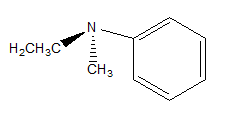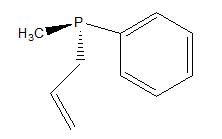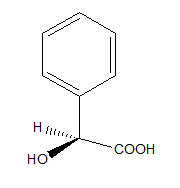
Among the following, the optically inactive compound is:
A) 
B)
C)
D)
Answer
221.7k+ views
Hint:To solve this question, it is required to have knowledge about chirality of an atom. An atom is considered to be chiral if and only if all the substituent groups attached to it are different. A compound which contains at least one chiral atom will be an optically active compound and will be able to form enantiomers of itself.
Complete step by step answer:
We shall analyse each compound to find out if it has a chiral atom or not:
In option A, we know that each carbon on benzene contains one hydrogen atom and has partial double bond with two carbon atoms. Thus, they are not chiral. The nitrogen atom attached to it forms three bonds. One is with the benzene ring, one is with an ethyl group and the other is with a methyl group. So, each of the bonds are with a different group. Thus, the nitrogen atom is chiral and the compound will be optically active.
In option B, we know that each carbon on benzene contains one hydrogen atom and has partial double bond with two carbon atoms. Thus, they are not chiral. The phosphorus atom attached to it forms three bonds. One is with the benzene ring, one is with the methyl group and the last one is with an allylic group with three carbons. So, each of the bonds are with a different group. Thus, the phosphorus atom is chiral and the compound will be optically active.
In option C, the compound is an allene with each of the substituents as different halogen. Though the substituents are different, the presence of a double bond on the carbons will make them achiral atoms. Thus, the compound will be optically inactive.
In option D, we know that each carbon on benzene contains one hydrogen atom and has partial double bond with two carbon atoms. Thus, they are not chiral. The carbon attached to it has four bonds. One is with the benzene ring, one is with hydrogen, one is with hydroxide and the last one is with a carboxylic group. As all the bonds are with a different group thus, the carbon will be chiral. Thus, the compound will be optically active.
$\therefore $ The correct option is option C.
Note: All compounds form mirror images, but only the mirror images which do not superimpose with each other are called enantiomers and form optically active compounds. The images which do not superimpose with each other and are also not mirror images of each other are called diastereomers.
Complete step by step answer:
We shall analyse each compound to find out if it has a chiral atom or not:
In option A, we know that each carbon on benzene contains one hydrogen atom and has partial double bond with two carbon atoms. Thus, they are not chiral. The nitrogen atom attached to it forms three bonds. One is with the benzene ring, one is with an ethyl group and the other is with a methyl group. So, each of the bonds are with a different group. Thus, the nitrogen atom is chiral and the compound will be optically active.
In option B, we know that each carbon on benzene contains one hydrogen atom and has partial double bond with two carbon atoms. Thus, they are not chiral. The phosphorus atom attached to it forms three bonds. One is with the benzene ring, one is with the methyl group and the last one is with an allylic group with three carbons. So, each of the bonds are with a different group. Thus, the phosphorus atom is chiral and the compound will be optically active.
In option C, the compound is an allene with each of the substituents as different halogen. Though the substituents are different, the presence of a double bond on the carbons will make them achiral atoms. Thus, the compound will be optically inactive.
In option D, we know that each carbon on benzene contains one hydrogen atom and has partial double bond with two carbon atoms. Thus, they are not chiral. The carbon attached to it has four bonds. One is with the benzene ring, one is with hydrogen, one is with hydroxide and the last one is with a carboxylic group. As all the bonds are with a different group thus, the carbon will be chiral. Thus, the compound will be optically active.
$\therefore $ The correct option is option C.
Note: All compounds form mirror images, but only the mirror images which do not superimpose with each other are called enantiomers and form optically active compounds. The images which do not superimpose with each other and are also not mirror images of each other are called diastereomers.
Recently Updated Pages
The hybridization and shape of NH2 ion are a sp2 and class 11 chemistry JEE_Main

What is the pH of 001 M solution of HCl a 1 b 10 c class 11 chemistry JEE_Main

Aromatization of nhexane gives A Benzene B Toluene class 11 chemistry JEE_Main

Show how you will synthesise i 1Phenylethanol from class 11 chemistry JEE_Main

The enolic form of acetone contains a 10sigma bonds class 11 chemistry JEE_Main

Which of the following Compounds does not exhibit tautomerism class 11 chemistry JEE_Main

Trending doubts
JEE Main 2026: Application Form Open, Exam Dates, Syllabus, Eligibility & Question Papers

Derivation of Equation of Trajectory Explained for Students

Hybridisation in Chemistry – Concept, Types & Applications

Understanding the Angle of Deviation in a Prism

How to Convert a Galvanometer into an Ammeter or Voltmeter

Degree of Dissociation: Meaning, Formula, Calculation & Uses

Other Pages
NCERT Solutions For Class 11 Chemistry Chapter 7 Redox Reaction

JEE Advanced Marks vs Ranks 2025: Understanding Category-wise Qualifying Marks and Previous Year Cut-offs

Hydrocarbons Class 11 Chemistry Chapter 9 CBSE Notes - 2025-26

Thermodynamics Class 11 Chemistry Chapter 5 CBSE Notes - 2025-26

NCERT Solutions ForClass 11 Chemistry Chapter Chapter 5 Thermodynamics

Equilibrium Class 11 Chemistry Chapter 6 CBSE Notes - 2025-26




